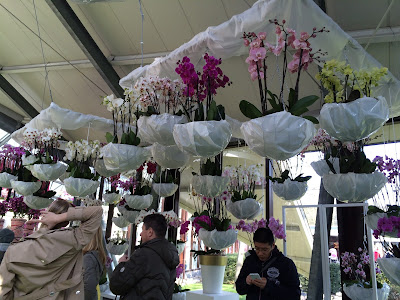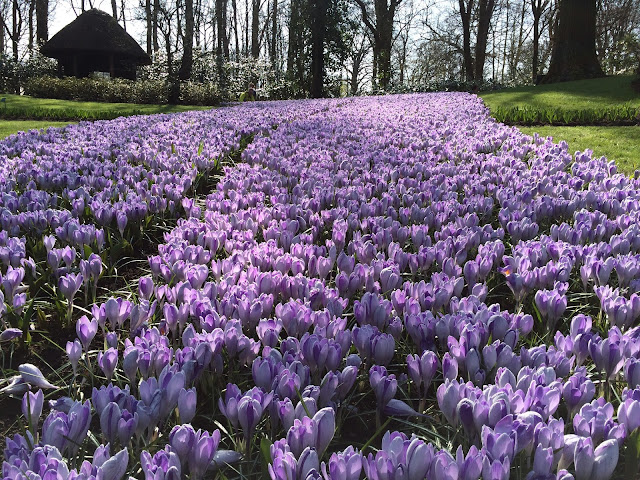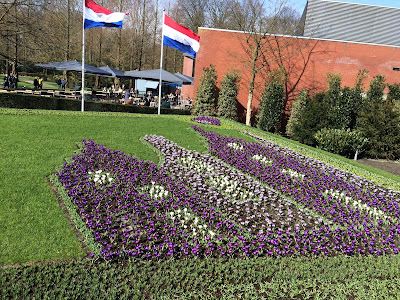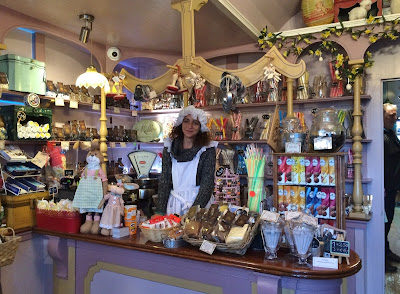Since the Area Office was closed Easter weekend from Good Friday through Easter Monday, that meant we had four days to "party"!!! We doubled with another senior couple, Jon and Janet Jensen, who serve in the legal department. Jon grew up in my neighborhood in Murray and was two years younger. The name didn't ring a bell when they first arrived, but I certainly recognized him when I first saw him.
After driving over four hours in non-stop rain, we arrived at our first destination, Kinderdijk, a long line of nineteen 300-year-old windmills. They were awesome to look at and even more awesome to tour. Luckily, the rain let up, and we were able to tour two of the windmills.
The small living room on the main floor was the only room with heat. Individual beds, not bedrooms, were found on various levels upstairs. Although it looked so sweet and cozy, imagine a whole family hanging out together in this small room!
Kitchen supplies were in the hallway. They probably cooked over the fireplace.
Here is one of a number of cute little beds tucked anywhere there was a space in the wall.
Former residents
Janet and I wondered if shaving the children's heads made for more room!
Janet and I wondered if shaving the children's heads made for more room!
Dutch version of a shoe rack!
This was the main room in the second windmill we toured. The owner still lives in this one! Probably cute place for a bachelor, but not so much for a large family!
Good view of one of the revolving gears, which took up a good portion of the interior!
The owner explained to us that the mechanism on top, which is anchored to the ground, can be untied and rotated to capitalize on the direction the wind is blowing. The ladder gives him access to the various moving parts in the windmill's housing.
We then drove to Leiden, where we checked into our hotel and changed into Sunday best as our next stop was the Hague Temple. We made the 7:30 session along with 35 or so others. The session was in Dutch, so we used head sets to follow along. The temple matron, whom I met, is the grandmother of one of the young missionaries serving here in our German branch!
I just love Mormon "small worlds"!
I just love Mormon "small worlds"!
The next morning found us at Keukenhof, tulip capital of the world! The trouble was, it was the second day of the season and probably two weeks too early! We saw lots of beautiful tulips in the greenhouses and a number of other flowers, but the massive amounts most tourists rave about will be raved about in another few weeks.
At least there were a fair number of tulips right at the entrance!
What there was, was beautiful!
Yet another quaint windmill...
...so we posed in front of it in a boat full of tulips!
Well, if the grounds didn't have enough blooming tulips, the greenhouse certainly did!
Elder G just had to take a break from all the "flower watching."
Luckily, he found a comfortable flowerpot nearby.
Aahhmazing!!!
Even though Elder G said this picture was for the grandkids, I think it was more for himself!
Next stop was the orchid greenhouse.
I had never ever seen so many orchids!
The grounds were beautifully manicured,
and we were thrilled to see other flowers already in bloom.
The next two pictures were a mosaic of the "Golden Age" of the Netherlands, when shipping was king and grand buildings lined the town squares.
They had one of those "band-music machines" (incorporating the sounds of 10+ instruments!!!) playing old-fashioned American tunes.
Our next stop was the Rijks Museum, the national museum of the Netherlands,
located in Amsterdam.
"The Night Watch" by Rembrandt is one of the most famous pieces there.
Other huge pieces by Rembrandt lined the walls of the main gallery.
Rembrandt's "Self-portrait as the Apostle Paul" "The Milkmaid" by Vermeer
Doll houses were furnished with the most exquisite miniature items.
These were made for the women of the 1600s, not little girls!
Amazing royal crib, carved wooden bed and dresser!

The scale-model sailing ship was Elder G's favorite!
The impressive library reminded us of the Library of Congress.
Self-portrait by Van Gogh. There was an entire Van Gogh museum close by,
but the lines were too long even to consider going there.
Since we've fallen in love with windmills, this was one of our favorite paintings.
After a lengthy discussion of the immense supply and varieties of food in this seemingly current (for the 1600s) scene, the lecturer pointed out the surprising guests in the background, Christ and Lazarus's sister Mary. It is Martha in the foreground who "...is cumbered about much serving..."
That evening we returned to Leiden and walked around the old section of town. Rembrandt was born there, and the pilgrims stayed there before sailing out on the Mayflower.
Sunday we attended the English-speaking branch near the temple and were glad to have added to the small attendance since everyone seemed to be gone for the Easter weekend.
After Church we headed to the small, historic town, Marken. It was an island until 1959, when it finally became possible to get there by vehicle when a dike and road were installed. It was like going back in history a few hundred years! Its small alleys, drawbridges, and closely built houses sitting atop protective mounds gave it a most authentic old-time atmosphere!
Don't miss the swan!
We had dinner on the wharf with the Jensens at this restaurant.
The Dutch version of appleskives, drizzled with caramel and Nutella, were finger-licking good!
Just the cutest, quaintest village ever!!!
Our last stop before leaving Marken was the Wooden Shoe Factory.
On Monday morning our last stop before returning to Frankfurt was Zaans Shanse, a restored Dutch village, much like Williamsburg in Virginia. It, too, has centuries' old windmills, cottages, and shops brought in from around the country and restored.
Note the famous Dutch Delft Blue tiles lining the fireplace and wall.
By the mid 1800s with the invention of the steam engine, the windmills were no longer used for removing water from the land. Instead, they were used to mill lumber and various grains, produce oil from linseed and canola seed, produce dyes, and much more. This particular mill was used to grind dyewoods for making paints. The gears and wheels were huge!
Farewell, the Netherlands!















































































